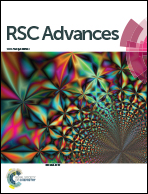Evolution in surface coverage of CH3NH3PbI3−XClXvia heat assisted solvent vapour treatment and their effects on photovoltaic performance of devices
Abstract
We demonstrate a facile and well controlled heat assisted solvent vapour treatment (HASVT) method for the growth of compact perovskite layers with good surface coverage areas in ambient atmosphere. The structural and optical properties of the as deposited and solvent vapour treated films have been investigated using SEM, XRD, UV-Vis and PL spectroscopy. Furthermore, photovoltaic devices in layered configuration (FTO/TiO2/CH3NH3PbI3−XClX/P3HT/Ag) are fabricated using as deposited and solvent vapour treated CH3NH3PbI3−XClX films. The photoactive perovskite films were treated with chlorobenzene solvent vapour using the HASVT method. The comparative photovoltaic performance of devices fabricated using as deposited and solvent vapour treated CH3NH3PbI3−XClX films was assessed. The maximum power conversion efficiency in the case of vapour treatment was estimated to be ∼8.05% as compared to the devices fabricated using as deposited films (∼5.51%). Our systematic investigations reveal that the enhancement in power conversion efficiency is due to modification in the structural and surface morphology of CH3NH3PbI3−XClX films.


 Please wait while we load your content...
Please wait while we load your content...